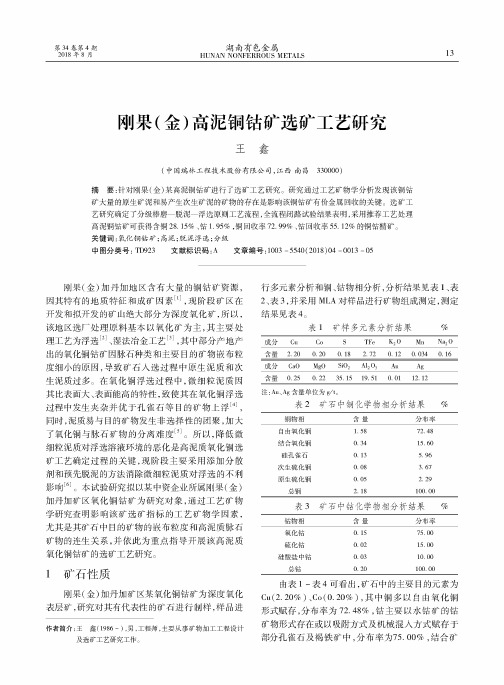刚果_金_某难选氧化铜钴矿选矿工艺研究_欧乐明
- 格式:pdf
- 大小:885.33 KB
- 文档页数:6

刚果(金)某铜钴矿开采方案研究
余浔
【期刊名称】《现代矿业》
【年(卷),期】2024(40)1
【摘要】以刚果(金)某铜钴矿为例,立足其资源分布特点,以采、选、冶三大工艺总体最优为理论基础,根据矿石性质和最佳选冶工艺对矿石类型进行再细分;结合各类矿石选冶处理工艺要求,分析了开采方案影响因素,对分期开采、选冶厂分期建设方案、开采顺序进行了研究。
最终确定采用分期开采+处理规模逐步扩大+选冶工艺流程与之配套逐步过渡方式,实现处理规模与矿石体量、品位合理匹配,促进了项目的建设及可持续发展,为今后的开发决策提供借鉴和参考。
【总页数】4页(P98-101)
【作者】余浔
【作者单位】中国瑞林工程技术股份有限公司
【正文语种】中文
【中图分类】F42
【相关文献】
1.刚果(金)铜钴氧化矿回收铜钴研究
2.刚果(金)加丹加省堪苏祁铜钴矿床铜钴矿特赋存状态研究
3.刚果(金)某铜钴矿开采边坡稳定性及敏感性分析
4.刚果(金)高炭质页岩铜钴矿脱碳精矿回收铜钴试验研究
5.刚果(金)SICOMINES铜钴矿提高铜、钴选矿回收率研究与实践
因版权原因,仅展示原文概要,查看原文内容请购买。


第34卷第4期湖南有色金属2018 年 8 月HUNANNONFERROUS METALS刚果(金)高泥铜钴矿选矿工艺研究王鑫(中国瑞林工程技术股份有限公司,江西南昌330000)摘要:针对刚果(金)某高泥铜钴矿进行了选矿工艺研究。
研究通过工艺矿物学分析发现该铜钴矿大量的原生矿泥和易产生次生矿泥的矿物的存在是影响该铜钴矿有价金属回收的关键。
选矿工艺研究确定了分级棒磨一脱泥一浮选原则工艺流程,全流程闭路试验结果表明,采用推荐工艺处理高泥铜钴矿可获得含铜28. 15%、钴1.95% ,铜回收率72. 99%、钴回收率55. 12%的铜钴精矿。
关键词:氧化铜钴矿;高泥;脱泥浮选;分级中图分类号:TD923 文献标识码:A文章编号:1003 -5540(2018)04 -0013 -05刚果(金)加丹加地区含有大量的铜钴矿资源,因其特有的地质特征和成矿因素[1],现阶段矿区在 开发和拟开发的矿山绝大部分为深度氧化矿,所以,该地区选厂处理原料基本以氧化矿为主,其主要处 理工艺为浮选[]、湿法冶金工艺[],其中部分产地产 出的氧化铜钴矿因脉石种类和主要目的矿物嵌布粒 度细小的原因,导致矿石入选过程中原生泥质和次 生泥质过多。
在氧化铜浮选过程中,微细粒泥质因 其比表面大、表面能高的特性,致使其在氧化铜浮选 过程中发生夹杂并优于孔雀石等目的矿物上浮[],同时,泥质易与目的矿物发生非选择性的团聚,加大 了氧化铜与脉石矿物的分离难度[]。
所以,降低微 细粒泥质对浮选溶液环境的恶化是高泥质氧化铜选 矿工艺确定过程的关键,现阶段主要采用添加分散 剂和预先脱泥的方法消除微细粒泥质对浮选的不利 影响[]。
本试验研究拟以某中资企业所属刚果(金)加丹加矿区氧化铜钴矿为研究对象,通过工艺矿物 学研究查明影响该矿选矿指标的工艺矿物学因素,尤其是其矿石中目的矿物的嵌布粒度和高泥质脉石 矿物的连生关系,并依此为重点指导开展该高泥质 氧化铜钴矿的选矿工艺研究。

矿业工程黄 金GOLD2024年第3期/第45卷刚果金某含碳硫氧混合铜矿石浮选试验收稿日期:2023-11-12;修回日期:2023-12-08作者简介:张书超(1990—),男,工程师,硕士,从事复杂低品位铜矿浮选与锂矿浮选工作;E mail:1799567686@qq.com张书超,代 定(浙江华友钴业股份有限公司)摘要:刚果金某含碳硫氧混合铜矿铜品位1.27%,矿石氧化率25.98%,选别过程中存在药剂消耗量高、易泥化、选别指标低等问题。
为实现该混合铜矿资源的高效利用,对其开展浮选试验研究。
研究结果表明:在硫氢化钠用量为460g/t、丁基黄药用量为190g/t、Z200用量为120g/t、2号油用量为180g/t的条件下,采用两粗两扫三精的混合浮选工艺流程,可获得铜品位17.10%、铜回收率80.76%的铜精矿。
关键词:硫氧混合铜矿;含碳;氧化铜矿;含硫;混合浮选 中图分类号:TD952 文章编号:1001-1277(2024)03-0046-04文献标志码:Adoi:10.11792/hj20240311引 言世界铜矿资源主要包括硫化铜矿、氧化铜矿及硫氧混合铜矿。
硫氧混合铜矿通常采用黄药类捕收剂优先回收硫化铜矿,再以硫化钠或硫氢化钠为硫化剂通过混合浮选或先硫后氧工艺流程实现氧化铜矿的回收[1-2]。
随着优质硫化铜矿资源的减少及社会对铜资源需求的增加,氧化铜矿资源的开发利用变得更加重要。
尽管氧化铜矿具有开发潜力,但其矿石性质复杂,不同类型铜矿的表面性质差异大、与脉石矿物共生关系复杂,同时存在含泥量较高等缺点。
特别是对于亲水性高且硫化困难的氧化铜矿,如硅孔雀石和蓝铜矿等,通常需要添加大量硫化钠。
然而,过高的硫化钠用量可能抑制硫化铜矿的回收,导致硫化铜矿金属后移和金属流失。
此外,含碳物质存在微细粒嵌布特征,这也严重影响目的矿物的可浮性和选别指标,从而导致药剂消耗量增加、成本上升及选别指标下降[3-4]。

刚果(金)某铜钴矿选矿工艺研究赵立涛【摘要】Aiming at such characteristics of a copper-cobalt ore in Congo (Kinshasa) as high grade,composition complex,subtle disseminated extent,serious sliming and high content of deleterious impurity (Ca,Mg),a flowsheet in principle was formulated,i.e.sulphide ore first,and then oxidized ore,oxidized ore using asynchronous flotation technology.First flotation can be oxidized copper ore with good sex of flotation,and then concentration flotation can be oxidized copper ore with difficult sex of flotation,and middling regrinding new technology.Raw ore(Cu 3.60%) was finally treated by closed test process.The total recovery of the copper concentrate of the copper sulfide and copper oxide is 84.74%,and the total recovery of the cobalt concentrate of the copper sulfide and copper oxide is 61.38%.The grade of Cu and Co is respectively 0.58% and 0.068% in the tailings.%针对刚果(金)某铜矿品位较高、成分复杂、嵌布粒度细微、易泥化、钙镁等有害杂质含量较高的特点,采用先硫化矿后氧化矿,氧化矿采用异步浮选工艺,先浮选可浮选性好的氧化铜矿,难浮选的氧化铜采用集中浮选、中矿再磨的创新工艺,最大限度地提高铜、钴的回收率.对含铜3.6%的原矿,采用最终闭路试验流程处理.硫化铜和氧化铜精矿铜总的回收率是84.74%,硫化铜和氧化铜精矿钴总回收率为61.38%.尾矿中Cu品位0.58%,Co品位0.068%.【期刊名称】《中州煤炭》【年(卷),期】2017(039)005【总页数】5页(P137-140,145)【关键词】铜钴矿;氧化铜矿;易泥化;异步浮选;辉铜矿【作者】赵立涛【作者单位】华北有色工程勘察院有限公司,河北石家庄050021【正文语种】中文【中图分类】TD952刚果(金)铜钴矿带闻名于世,欧美地质学者早就在赞比亚—刚果(金)铜矿带开展了区域地质调查。

7冶金冶炼M etallurgical smelting刚果(金)铜钴矿选冶工艺及联合处理方案研究赵 凯,施 帅,邹晨杰,王 皓(金川集团股份有限公司,甘肃 金昌 737100)摘 要:选矿方面,目前浮选仍是铜钴矿最主要的选矿方法,选别流程一般分为优先浮和混合浮选。
对混合矿通常采用先硫后氧或磁浮联合工艺,对硫化矿则采用黄药类捕收剂选别处理即可。
冶金方面,随着萃取工艺的发展和高效萃取剂的研发应用,依靠萃取技术在提纯铜钴酸浸液的优势越来越显著;火法焙烧工艺方面,随着焙烧烟气处理技术的发展应用以及低浓度SO2制酸技术趋于成熟,不仅可以解决焙烧过程中烟气污染问题,还能实现原料中硫资源的高效回收利用。
选冶结合、火法湿法联合的处理方案,可以充分发挥各自优势,尽可能高效经济回收多种有价金属,为综合利用刚果(金)及周边区域铜钴矿资源打下坚实的基础。
关键词:铜钴矿;选矿;火法熔炼;湿法冶炼中图分类号:TD952 文献标识码:A 文章编号:1002-5065(2023)17-0007-3Research on the beneficiation and smelting process and joint treatment plan of copper andcobalt ore in Congo (Kinshasa)ZHAO Kai, SHI Shuai, ZOU Chen-jie, WANG Hao(Jinchuan Group Co. Ltd,Jinchang 737100,China)Abstract: In terms of beneficiation, flotation is still the main beneficiation method for copper cobalt ore, and the beneficiation process is generally divided into priority flotation and mixed flotation. For mixed ore, a combined process of sulfur followed by oxygen or magnetic levitation is usually used, while for sulfide ore, a xanthate type collector can be used for sorting treatment. In terms of metallurgy, with the development of extraction processes and the development and application of efficient extractants, the advantage of relying on extraction technology in purifying copper cobalt acid leaching solution is becoming increasingly significant; In terms of fire roasting process, with the development and application of roasting flue gas treatment technology and the maturity of low concentration SO2 acid production technology, it can not only solve the problem of flue gas pollution during the roasting process, but also achieve efficient recovery and utilization of sulfur resources in raw materials. The treatment plan combining selection and metallurgy, as well as the combination of fire and wet processes, can fully leverage their respective advantages and efficiently and economically recover various valuable metals, laying a solid foundation for the comprehensive utilization of copper and cobalt ore resources in the Democratic Republic of Congo and surrounding areas.Keywords: copper cobalt ore; Mineral processing; Fire melting; Hydrometallurgy收稿日期:2023-06作者简介:赵凯,男,生于1990年,汉族,甘肃张掖人,本科,选矿中级工程师,研究方向:镍铜钴等有色金属选矿及火法、湿法冶金。
2023年 8月下 世界有色金属111矿产资源M ineral resources刚果(金)某铜钴矿选矿工艺试验研究赵 凯,施 帅,邹晨杰,黄铁胜(金川集团股份有限公司,甘肃 金昌 737100)摘 要:刚果(金)某铜钴多金属矿床铜钴储量大,具有极高的回收价值。
针对该矿山资源,开展了选矿工艺研究,结果表明:原矿中铜和钴主要以硫化矿的形式存在,同时含有少量的氧化矿矿物。
在磨矿细度为-0.106mm含量为80%时,铜和钴的回收率最高,磨矿细度控制在该条件下最有利于浮选。
随着矿样氧化率的提升,铜和钴的回收率明显下降。
当矿样氧化率超过15%时,铜和钴的回收率下降较明显。
在生产中配矿至氧化矿含量为15%以内后再进行矿石选别作业较为适合。
采用“先硫后氧+中矿再磨再选”的工艺流程,所配矿样的铜、钴回收率均较为理想,能够满足冶炼加工工艺要求。
关键词:铜钴矿;选矿;工艺试验中图分类号:TD95 文献标识码:A 文章编号:1002-5065(2023)16-0111-3Experimental Study on Mineral Processing Technology of a Copper Cobalt Mine in Democratic Republic of CongoZHAO Kai, SHI Shuai, ZOU Chen-jie, HUANG Tie-sheng(Jinchuan Group Co., Ltd.,Jinchang 737100,China)Abstract: A copper cobalt polymetallic deposit in the Democratic Republic of Congo has a large reserve of copper and cobalt, which has extremely high recovery value. A beneficiation process study was conducted on the mine resources, and the results showed that copper and cobalt in the raw ore mainly exist in the form of sulfide ore, while containing a small amount of oxidized mineral. When the grinding fineness is -0.106mm and the content is 80%, the recovery rate of copper and cobalt is the highest, and controlling the grinding fineness under this condition is most conducive to flotation. As the oxidation rate of the ore sample increases, the recovery rates of copper and cobalt significantly decrease. When the oxidation rate of the ore sample exceeds 15%, the recovery rate of copper and cobalt decreases significantly. It is more suitable to mix ore in production until the content of oxidized ore is within 15% before conducting ore sorting operations. The process flow of "sulfur first, oxygen+intermediate ore, grinding and then selection" is adopted, and the copper and cobalt recovery rates of the prepared ore samples are relatively ideal, which can meet the requirements of smelting and processing technology.Keywords: copper cobalt ore; Mineral processing; Process testing收稿日期:2023-06作者简介:赵凯,男,生于1990年,汉族,甘肃张掖人,本科,选矿中级工程师,研究方向:镍铜钴等有色金属选矿及火法、湿法冶金。